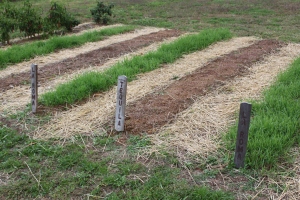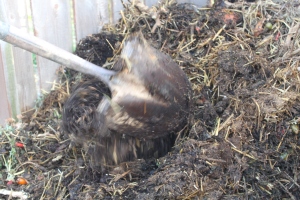PART 4 of 4: Today is the 4th and final post of our four-part series, Planting A Simple Garden Using Raised Row Beds. If you missed any of the the previous weeks (part 1,2 or 3) – you can click on the highlighted text below to view.
1. Growing Simple – Raised Row Gardening – Click Here For Part 1
2. Preparing And Planting The Garden – Click Here For Part 2
3. Planting And Maintaining Your Garden – Click Here For Part 3
4. Keeping Your Beds Productive – Today’s Post
Keeping Your Beds Productive:
Whether you have a raised row bed garden, a sizeable garden patch, or plant your garden in containers – keeping your soil productive and full of life is the key to good yields year in and year out. With a few simple steps, you can have great fresh vegetables every summer. Here are 3 ways to keep that garden soil working for you!
1.COVER CROPS:

Cover crops add organic matter to your soil and keep valuable topsoil from eroding over the winter months
In the fall, after your plants have run their course and the last of the harvest has been brought in – it’s time to really increase your soil’s vitality. Cover crops are really the key to a long-term garden’s success – and they are easy to plant! They add back tons of nutrients to the soil, keep other weeds from getting established in your rows, and help keep soil erosion to a minimum. No need to till your soil – just rake out your rows, existing garden, or your raised beds in the fall after harvest – and scatter the seeds (annual rye is a great choice) as if you were throwing grass seed on your lawn. Next, just gently rake it over and you’re done! It’s okay if you still see seeds on top – they will sprout soon enough and you will have a great cover crop growing! Early next Spring, simply dig it under and plant your garden. We don’t use a tiller at all in our raised row beds – just a pitchfork to turn it over, and we are ready to plant. We actually have a complete tutorial dedicated to cover crop benefits that you can check out here : Planting Cover Crops
2. Add Organic Matter Any Chance You Get:
In addition to using cover crops – adding even more organic matter to your garden will pay huge dividends. One of the great advantages to the raised row system is that you can conserve by adding available materials to only areas you grow your crops in – not wasting it in the walking rows.
What can I add? Leaves, Grass Clippings and Compost!
If you have access to extra leaves or clippings in the fall and spring – you can add directly to the rows – and let them decompose right in the soil as your plants or cover crops grow. Make a small 6″ trench in the middle of each row and bury a 3 to 5 inch layer of the shredded material, then cover back up with soil. You can do this in the fall before you plant your cover crops, or in the spring before you plant your beds. This is also a great way to add compost to your rows if you have a lot of it available. We also use generous amounts of compost in every planting hole and as a mulch and side dressing for plants to keep enriching our soil.
If you don’t currently compost – get started now! Compost is the key to long-term healthy plants, soil and gardening – and without having to use expensive and soil damaging fertilizers! We have written several articles on composting – but here is one that really sums it all up for those that want to get started: Composting 101
3.Rotate Your Crops:

Rotating what you grow and where will help to keep your plants and healthy and soil borne diseases at bay.
It’s so important to practice crop rotation – even on a small-scale garden basis. If you keep planting tomatoes in the same spot – you won’t keep getting the same results. Different plants require different nutrients – and soil begins to lose those nutrients if the same crops keep going into the same place. In addition – soil borne diseases that can wreak havoc on garden plants can take hold easier if the same soil and plants are together year after year. So make sure you plan out different spaces for plants in your garden plan each year to rotate those crops.
So there you have it! The end of our four-part series on Raised Row Gardening! Make sure to look for more posts in the coming months about gardening, DIY and more. If you would like to follow along through the coming year and receive our weekly DIY and Gardening Posts – be sure to sign up to follow our blog via email, Twitter or Facebook in the right column.
Shared On Gnowfglins, Transformation Thursdays


